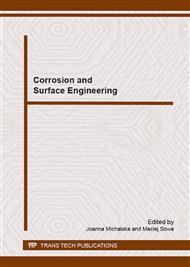p.275
p.281
p.286
p.290
p.294
p.298
p.302
p.309
p.313
Microbiologically Induced Corrosion Monitoring Using Open-Circuit Potential (OCP) Measurements
Abstract:
This study investigates how sulfate-reducing bacteria (SRB) influence the process of microbiologically induced corrosion (MIC) of carbon steel by measuring corrosion potential using open-circuit potential (OCP) measurements. MIC is mainly influenced by Desulfovibrio vulgaris, formerly known as Desulfovibrio desulfuricans subsp. Desulfuricans, deposited as spirillum desulfuricans, which produces D(-)-lactate dehydrogenase. This strain was recommended by ATCC to be used in the tests described in ASTM. A pure colony of SRB was isolated from the Baram and Sungai Ular areas in Malaysia. An evaluation of SRB growth was performed during the test in the inoculated medium anaerobically at 37 ̊. The results showed that the corrosion potential Eoc increases in the presence of SRB in pure and mixed cultures as compared to the control sample. These results indicate that the SRB caused the metal loss on the carbon steel surface through direct corrosive action of the H2S generated by the bacteria during their metabolic process of reducing sulfates to the sulfide form.
Info:
Periodical:
Pages:
294-297
Citation:
Online since:
January 2015
Price:
Сopyright:
© 2015 Trans Tech Publications Ltd. All Rights Reserved
Share:
Citation:


